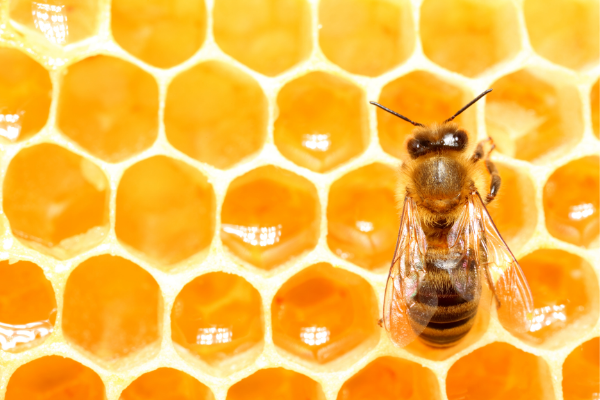
It’s summertime, which means bees are out to play. While bees are an essential part of our ecosystem and enhance the beauty of our gardens, bee stings are another story. They can be painful, cause swelling and if you’re allergic to them, it can mean a trip to the hospital. If you wish you knew more about bee stings and what to look out for when it comes to serious symptoms, we’ve got you covered. Plus, we’re sharing the bee sting remedies everyone should know this summer.
Bee Sting Versus Wasp Sting: What’s the Difference?
Bees and wasps can both sting, but their main differences lie in the venom, the pain and how many times they can sting. A bee’s stinging apparatus consists of a sac of venom attached to a barbed stinger. When bees sting, they implant the stinger into the skin, pumping venom into the tissue. When a bee stings, the hooked stinger holds in the skin and pulls out the inner abdomen of the bee. A bee can only sting once and then it dies, however wasps can sting multiple times. Bee stings are painful, but wasps are famously known for their painful stings. Wasps inject less venom but their stingers are smoother and can release cleanly. As a result, they can sting multiple times.
What Does a Bee Sting Look Like?
Bee stings typically result in a red or pink welt or swelling of the skin around the sting site. A central white spot usually appears where the stinger punctured your skin. The stinger will be left in your skin, so it’s important to remove it right away as it can continue to pump venom into the wound. Bee sting venom contains proteins that affect skin cells and the immune system, causing pain and swelling around the sting area. In people with a bee sting allergy, the venom can cause more serious symptoms.
8 Warning Signs You’re Allergic to Bee Stings
1. Itching, hives or swelling over a large part of your body (not just where you got stung)
2. Face, throat or tongue swelling
3. Trouble breathing
4. Wheezing or hoarseness
5. Dizziness
6. Stomach cramps
7. Nausea or diarrhea
8. Loss of consciousness
9. Turning pale or red faced
When to See a Doctor
If you develop swelling, hives, breathing problems or any of the symptoms mentioned above from a bee sting, you should seek medical attention as soon as possible. Call 911 or emergency services if you’re having a serious reaction to a bee sting, even if it’s just one or two signs or symptoms. You should also seek prompt medical care if you’ve been swarmed by bees and have multiple stings. If your mild symptoms don’t go away after a week, you should consult a doctor then as well.
8 Bee Sting Remedies That Work
1. Hydrocortisone Cream
Apply hydrocortisone cream or calamine lotion to ease redness, itching or swelling. Avoid scratching the sting area as this will worsen itching and swelling and increase your risk of infection.
2. Antihistamine
If the itching or swelling from your bee sting is bothersome, take an antihistamine with diphenhydramine (Benadryl) or chlorpheniramine. Antihistamines help our bodies calm down from an allergic response and are particularly relieving for itching and swelling.
3. Anti-Inflammatories
If you’re experiencing pain, you can try taking non-steroidal anti-inflammatory drugs such as Motrin or Advil. This can help lower your body’s inflammation and reduce pain.
4. Ice
A cold compress will reduce pain and swelling from the bee sting by limiting blood flow to the area. Make sure not to put ice or anything frozen (like a bag of frozen peas) directly on your skin as it can burn you. Wrap an ice pack or bag of frozen veggies in a cloth and ice for 15 to 20 minutes, then give your skin a break and repeat as needed.
5. Honey
Honey can help with wound healing and prevent infection. Manuka honey has been proven to lower inflammation and have strong antimicrobial properties. This means it can repel bacteria and fungi. It’s also believed that honey releases oxygen into the wound to aid healing and flush out dead tissue.
6. Aloe Vera Gel
Aloe vera gel is one of the best ways to soothe and moisturize irritated skin. It contains anti-inflammatory and antibacterial properties and spreading a little onto the affected area can reduce swelling and help keep the sting from becoming infected. You can buy the gel or make your own if you have an aloe plant. Break off a leaf and squeeze the gel directly on the sting.
7. Essential Oils
Certain essential oils have properties that make them ideal for relieving pain or swelling from a bee sting. Always mix essential oils with a carrier oil like coconut oil or olive oil before applying it to your skin. Lavender essential oil has anti-inflammatory abilities and can help reduce swelling. Tree tea oil is a natural antiseptic and can ease bee sting pain and prevent infection. Witch hazel is a natural astringent and antiseptic and is a go-to for insect bites to prevent infection and reduce swelling and pain.
8. Toothpaste
While there’s no scientific evidence to support its effectiveness, it’s believed that toothpaste is beneficial for neutralizing bee venom. Many people think that toothpaste will draw out bee venom, so it’s worth a shot. Mint varieties also provide a cool, soothing effect. Squeeze out and apply a small amount on the affected area.
If you or someone you know is stung by a bee this summer, make sure to try these remedies and seek medical attention if there are any signs of a severe allergic reaction. Here’s to a fun, safe summer!
